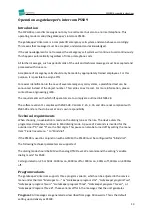
FWG09I Assembly instructions
25
Consultation protocol for the operation of an emergency call system
FWG09 as gatekeeper's intercom
Introductory Remarks
The operation of a lift emergency call system is subject to the legal requirements for the operator of
a lift system. So for example, compliance with the requirements of the Industrial Safety Regulation,
the technical guidelines of the Industrial Safety Regulation and all referenced guidelines such as
EN81-28 in its respective valid version or successor regulations.
The operator cannot pass on these
obligations and responsibilities to a third party
.
If an emergency call system FWG09 is correctly installed and connected to a call center which is
provided for this purpose in the protocol version, these requirements shall be regarded as fulfilled.
See also the declaration of conformity by TÜV Austria. The protocol version that has been provided is
deactivated for operation in gatekeeper mode.
In this case, the operator is therefore responsible for fulfilling these requirements in full or ensuring
similar arrangements. The general principle is that the receiving telephones be permanently manned
by appropriately trained staff. This requires different workflows depending on the program version
used.
Program version 1 (with corresponding documentation conforming to
EN81-28 without additional measures)
The unit generates all messages that it would otherwise also generate. All these messages are
reported to the receiving station and must be acknowledged via the DTMF commands on the
telephone keypad, because the emergency call system will continue to dial if there is no
acknowledgment. The test calls that have been made must be documented and it must be
determined whether a test call is made every 72 hours. If the test call is not made, the elevator must
be shut down until the emergency call system is working again. In addition, at least two telephone
numbers should be dialed, so that they can operate redundantly in the event of a hardware fault.
Program version 2 for parts based on SR 129 from TÜV Austria (possible
compromise between safety and usability with emergency call tests
compliant with EN81-28)
The majority of the technical messages are no longer generated to enable easier operation. The
messages generated must continue to be acknowledged via DTMF commands on the telephone
keypad.
Only alarm messages or technical messages about the operating status of the internal emergency
power supply are still dialed. For this reason, the messages that are no longer generated must be
replaced by an equivalent. This can be achieved if the emergency call is successfully tested every
three days until the voice communication phase is reached and this successful test is documented in
writing. This form of documentation is simpler than an evaluation of whether certain messages have
been taken within the period prescribed. In addition, at least two telephone numbers should be
called, so that they can operate redundantly in the event of a hardware fault.
















